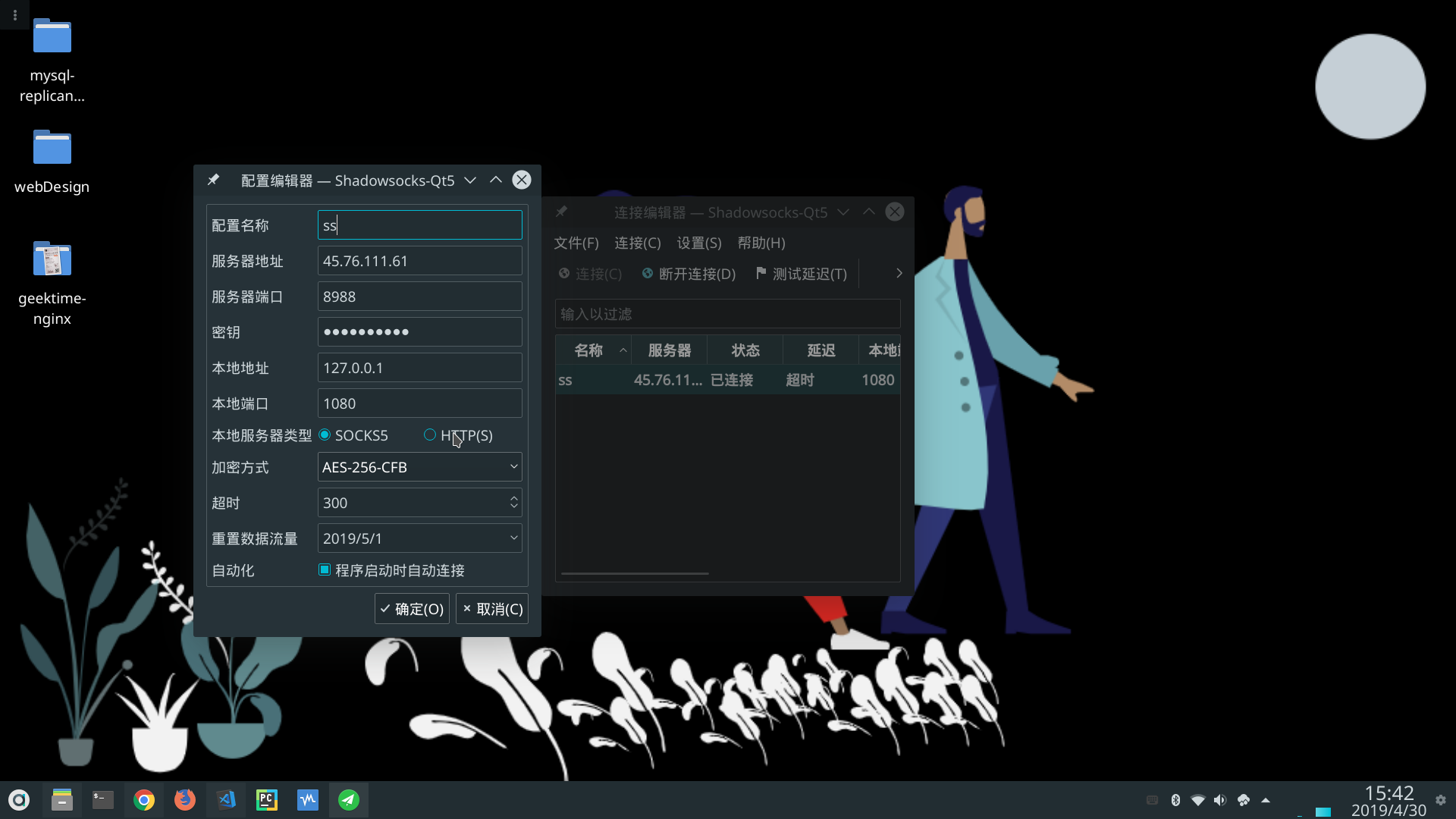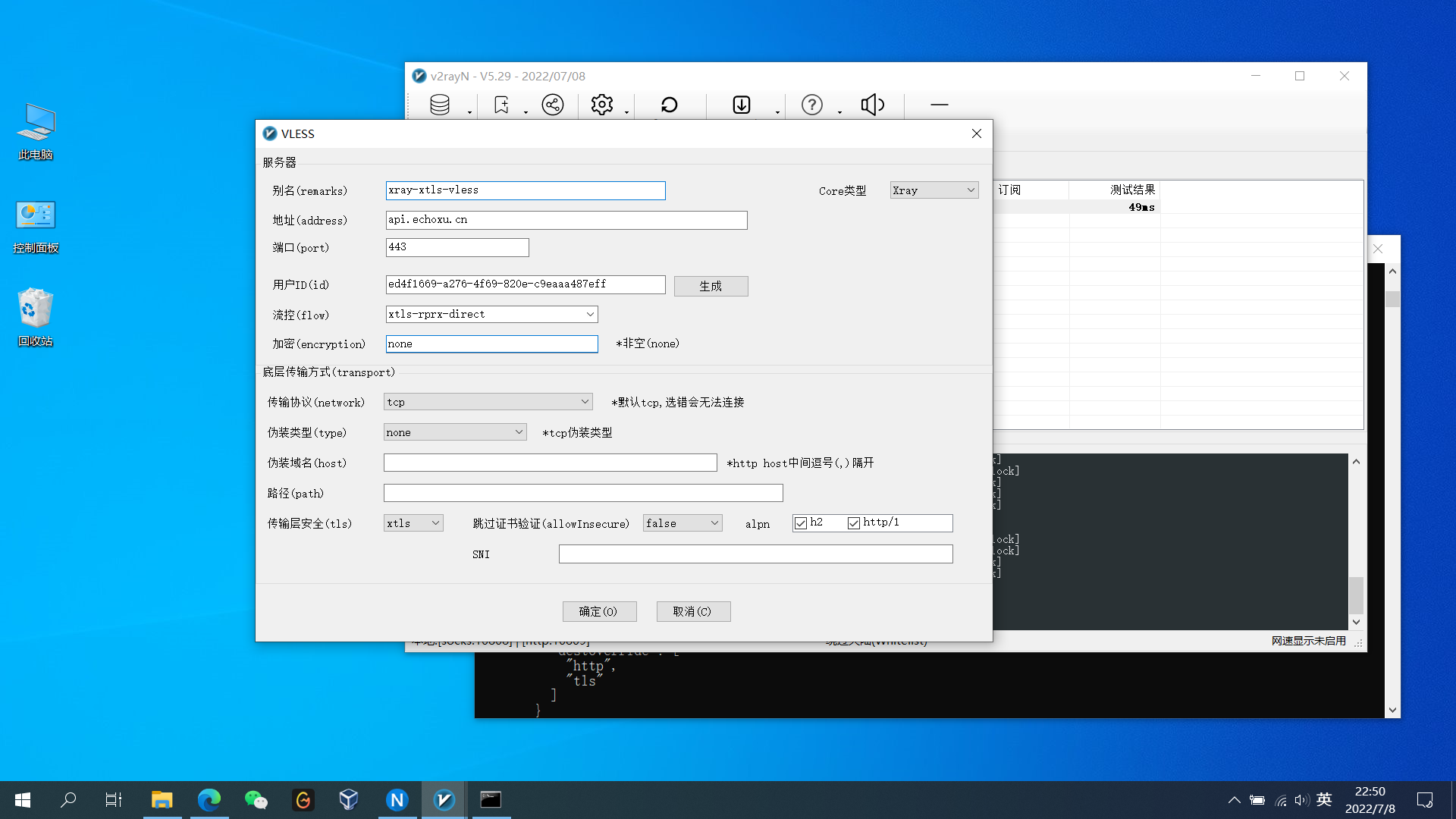搭建 ss 服务器
搭建原因不细说了,大家都懂.先在 vultr 购买日本的 vps,选择 centos7 系统,目前用 centos8 系统会导致每隔 10 分钟左右就需要重新更改端口。
安装 ss 服务
- 安装 ss 依赖库并安装 ss
yum -y install wget vim git epel-release
yum -y install libsodium python34-pip m2crypto #需安装 epel,libsodium 和 m2crypto 与加密有关,m2crypto 会提升加密速度.
/usr/bin/pip3.4 install git+https://github.com/shadowsocks/shadowsocks.git@master
- 启用 fastopen
echo 3 > /proc/sys/net/ipv4/tcp_fastopen
- 支持更多的 tcp 连接
vi /etc/security/limits.conf
添加如下:
* soft nofile 51200
* hard nofile 512002
在启动 ssserver 之前让其临时生效: ulimit -n 51200
- 优化内核参数
vim /etc/sysctl.conf
添加如下:
fs.file-max = 51200
net.core.rmem_max = 67108864
net.core.wmem_max = 67108864
net.core.netdev_max_backlog = 250000
net.core.somaxconn = 4096
net.ipv4.tcp_syncookies = 1
net.ipv4.tcp_tw_reuse = 1
net.ipv4.tcp_tw_recycle = 0
net.ipv4.tcp_fin_timeout = 30
net.ipv4.tcp_keepalive_time = 1200
net.ipv4.ip_local_port_range = 10000 65000
net.ipv4.tcp_max_syn_backlog = 8192
net.ipv4.tcp_max_tw_buckets = 5000
net.ipv4.tcp_fastopen = 3
net.ipv4.tcp_mem = 25600 51200 102400
net.ipv4.tcp_rmem = 4096 87380 67108864
net.ipv4.tcp_wmem = 4096 65536 67108864
net.ipv4.tcp_mtu_probing = 1
net.ipv4.tcp_congestion_control = hybla2
3
4
5
6
7
8
9
10
11
12
13
14
15
16
17
18
19
20
21
使其生效: sysctl -p
- 新建 ss 配置文件
vim /etc/shadowsocks.json
{
"server":"购买的vps服务器的IP",
"server_port":8988, #随便写个端口
"local_address": "127.0.0.1", #不用改
"local_port":1080, #不用改
"password":"设置个密码", #这个和vps的登录密码是不同的
"timeout":600,
"method":"chacha20-ietf-poly1305", # 加密方式推荐选用 chacha20-ietf-poly1305" or "aes-256-gcm,默认是aes-256-cfb
"fast_open": true # 需开启centos的fastopen参数,默认是false
}2
3
4
5
6
7
8
9
10
- ss 多用户相关配置
此操作非必须,在你想给其他人分享此 ss 服务器但又不想让他和你共用一个 ss 端口及密码时才需要配置此项.
vim /etc/shadowsocks.json
多用户配置文件内容如下:
{
"server":"149.28.77.99",
"port_password":{
"10988":"mypasswd", # 10988是端口,mypasswd是密码
"10999":"passwd" #想添加几个用户就添加几项此内容,但最后一项不能用逗号结尾
},
"local_address": "127.0.0.1",
"local_port":1080,
"timeout":600,
"method":"chacha20-ietf-poly1305",
"fast_open": true
}2
3
4
5
6
7
8
9
10
11
12
配置完成后还是用命令ssserver -c /etc/shadowsocks.json -d start/stop/restart启动或重启.
详细配置请参考: ss 多用户配置
- ss 命令:
ssserver -c /etc/shadowsocks.json -d start/stop/restart
查看 ss 日志:
sudo less /var/log/shadowsocks.log
- 修改登录密码
passwd root
- ssh 安全设置
需先关闭 selinux,setenforce 0
vim /etc/ssh/sshd_config
Port 10222
PermitEmptyPasswords no
PasswordAuthentication no
UseDNS no2
3
4
生成 ssh-key 秘钥 ssh-keygen -t rsa -b 4096 -f ~/.ssh/id_rsa_ss
将~/.ssh/id_rsa_ss.pub上传到 vps 服务器并改名为authorized.keys
- firewalld 配置
如果使用 firewalld 作为默认防火墙请使用如下配置:
firewall-cmd --zone=public --list-ports
firewall-cmd --state
firewall-cmd --get-active-zones
firewall-cmd --zone=public --list-rich-rules
firewall-cmd --zone=public --add-port=8988/tcp --permanent
firewall-cmd --zone=public --add-port=10222/tcp --permanent
firewall-cmd --list-service
firewall-cmd --reload2
3
4
5
6
7
8
- iptables 配置
如果使用 iptables 作为默认防火墙请使用如下配置
systemctl stop firewalld
systemctl disable firewalld
yum -y install iptables-services
防火墙设置脚本
iptables -A INPUT -p tcp -m state --state RELATED,ESTABLISHED -j ACCEPT
iptables -A INPUT -i lo -j ACCEPT
iptables -A INPUT -p tcp -d 127.0.0.1 -s 127.0.0.1 -j ACCEPT
iptables -A INPUT -p tcp -m multiport --dports 8988,443,10222 -m state --state NEW -j ACCEPT
iptables -A INPUT -p udp -m udp --sport 53 -j ACCEPT
iptables -A INPUT -p udp -m udp --dport 53 -j ACCEPT
iptables -A INPUT -p icmp --icmp-type 8 -m limit --limit 5/minute --limit-burst 5 -j ACCEPT
iptables -A INPUT -p icmp -m icmp --icmp-type 0 -j ACCEPT
iptables -P INPUT DROP
iptables -P FORWARD DROP
iptables -P OUTPUT ACCEPT
systemctl start iptables
systemctl enable iptables
rm -rf /etc/sysconfit/iptables
rm -rf /etc sysconfit/iptables.sava
service iptables save2
3
4
5
6
7
8
9
10
11
12
13
14
15
16
- ss 开机启动
将 ss 服务添加到 rc.local 中
vim /etc/rc.local
添加如下内容:
/usr/bin/ssserver -c /etc/shadowsocks.json -d start安装 ss 客户端
因为本人使用的是 linux 系统所以只介绍下 linux 下 ss 客户端的配置,linux 下的 ss 客户端可使用 shadowsocks-Qt5 安装 ss-client:
sudo pacman -S shadowsocks-qt5

网络代理设置
网络代理分为全局和浏览器代理
- 全局设置 通过全局设置代理后所有的流量都走代理,以至于连访问国内的网站都走的代理,所以会很慢.

- 安装浏览器代理插件 (推荐使用)
chrome 浏览器:
打开 chrome 浏览器,进入到设置---系统---打开您计算机的代理设置这样就会自动打开你电脑上的代理设置,然后新建一个SOCKS代理,地址填:127.0.0.1,端口填:1080.
这里的前提是你已搭建好 ss 服务器以及完成了本地的 ss 客户端配置.
此时你应该可以打开 google 应用商店了,然后在里面搜索Proxy SwitchyOmega安装并启用,再参照上文添加一条 socks 代理即可.此时就可以关闭操作系统的 socks 代理了.
firefox 或者 chromium:
如果是 firefox 或者 chromium 可以去ss 浏览器插件下载地址:下载插件,然后将下载好的插件拖到浏览器-扩展项目里并启用即可.
注意
ss 浏览器插件(SwitchyOmega)目前只适用于 chromium 和 firefox 并不能用于 chrome 浏览器.
设置 ss 快捷登录别名
设置 ss 别名:
vim ~/.bashrc
在其末尾添加:
alias ss='ssh 45.76.111.61'
让配置生效
source ~/.bashrc
添加秘钥: 在使用多个 ssh-key 时通过 config 文件管理多个 ssh-key 秘钥
vim ~/.ssh/config
# ss
Host 45.76.111.61
HostName 45.76.111.61
PreferredAuthentications publickey
User root
Port 10222
IdentityFile ~/.ssh/id_rsa_ss2
3
4
5
6
7
配置多个 ssh-key 相关内容请参考:
配置完成后就可以用 ss 直接登录 vps 服务器了。
ss 代理 openwrt 源
访问 openwrt 源比较慢,所以想通过 ss 实现代理访问 openwrt 源.
实现原理:
安装 nginx
1: 先安装 yum 扩展包
sudo yum install yum-utils
2: 新增 nginx.repo 文件
sudo vim /etc/yum.repos.d/nginx.repo
添加:
[nginx-stable]
name=nginx stable repo
baseurl=http://nginx.org/packages/centos/$releasever/$basearch/
gpgcheck=1
enabled=1
gpgkey=https://nginx.org/keys/nginx_signing.key
module_hotfixes=true
[nginx-mainline]
name=nginx mainline repo
baseurl=http://nginx.org/packages/mainline/centos/$releasever/$basearch/
gpgcheck=1
enabled=0
gpgkey=https://nginx.org/keys/nginx_signing.key
module_hotfixes=true2
3
4
5
6
7
8
9
10
11
12
13
14
15
3: 启用 nginx 源
sudo yum-config-manager --enable nginx-mainline
4: 安装 nginx
sudo yum install nginx
配置 nginx 代理
sudo vim /etc/nginx/conf.d/default.conf
使其内容为:
server {
listen 9080;
server_name 149.28.236.188;
add_header Access-Control-Allow-Origin *;
add_header Access-Control-Allow-Headers X-Requested-With;
add_header Access-Control-Allow-Methods GET,POST,OPTIONS;
access_log /var/log/nginx/host.access.log main;
location / {
root /usr/share/nginx/html;
index index.html index.htm;
}
location /openwrt_core/ {
proxy_pass http://downloads.openwrt.org/releases/19.07.2/targets/ramips/mt7621/packages/;
}
location /openwrt_kmods/ {
proxy_pass http://downloads.openwrt.org/releases/19.07.2/targets/ramips/mt7621/kmods/4.14.171-1-2e88863ccdd594fb8e842df3c25842ee/;
}
location /openwrt_base/ {
proxy_pass http://downloads.openwrt.org/releases/19.07.2/packages/mipsel_24kc/base/;
}
location /openwrt_luci/ {
proxy_pass http://downloads.openwrt.org/releases/19.07.2/packages/mipsel_24kc/luci/;
}
location /openwrt_packages/ {
proxy_pass http://downloads.openwrt.org/releases/19.07.2/packages/mipsel_24kc/packages/;
}
location /openwrt_routing/ {
proxy_pass http://downloads.openwrt.org/releases/19.07.2/packages/mipsel_24kc/routing/;
}
location /openwrt_telephony/ {
proxy_pass http://downloads.openwrt.org/releases/19.07.2/packages/mipsel_24kc/telephony/;
}
error_page 500 502 503 504 /50x.html;
location = /50x.html {
root /usr/share/nginx/html;
}
}2
3
4
5
6
7
8
9
10
11
12
13
14
15
16
17
18
19
20
21
22
23
24
25
26
27
28
29
30
31
32
33
34
35
36
37
38
39
40
41
42
43
44
45
46
47
48
49
启动 nginx: /usr/sbin/nginx
防火墙中开放 9080 端口
firewall-cmd --zone=public --add-port=9080/tcp --permanent
firewall-cmd --reload
配置 openwrt
在 openwrt 中的 系统---software---Configure opkg---opkg/distfeeds.conf中添加如下内容:
src/gz openwrt_core http://149.28.236.188:9080/openwrt_core
src/gz openwrt_kmods http://149.28.236.188:9080/openwrt_kmods
src/gz openwrt_base http://149.28.236.188:9080/openwrt_base
src/gz openwrt_luci http://149.28.236.188:9080/openwrt_luci
src/gz openwrt_packages http://149.28.236.188:9080/openwrt_packages
src/gz openwrt_routing http://149.28.236.188:9080/openwrt_routing
src/gz openwrt_telephony http://149.28.236.188:9080/openwrt_telephony2
3
4
5
6
7
再重新执行opkg update会发现速度快了很多.
下面的是 openwrt 默认的源:
src/gz openwrt_core http://downloads.openwrt.org/releases/19.07.2/targets/ramips/mt7621/packages
src/gz openwrt_kmods http://downloads.openwrt.org/releases/19.07.2/targets/ramips/mt7621/kmods/4.14.171-1-2e88863ccdd594fb8e842df3c25842ee
src/gz openwrt_base http://downloads.openwrt.org/releases/19.07.2/packages/mipsel_24kc/base
src/gz openwrt_luci http://downloads.openwrt.org/releases/19.07.2/packages/mipsel_24kc/luci
src/gz openwrt_packages http://downloads.openwrt.org/releases/19.07.2/packages/mipsel_24kc/packages
src/gz openwrt_routing http://downloads.openwrt.org/releases/19.07.2/packages/mipsel_24kc/routing
src/gz openwrt_telephony http://downloads.openwrt.org/releases/19.07.2/packages/mipsel_24kc/telephony2
3
4
5
6
7
WARNING
配置 openwrt 源时不用安装 ss 服务端和客户端,只需要用到 nginx.
v2ray+websocket+TLS+Nginx
目前 ss 已经很不稳定了,所以换了 v2ray,通过 nginx+websocket+TLS 来伪装流量.
如何选取适合自己的配置

常见的配置有:
1: websocket+tls+nginx
2: http2+tls+caddy
原理
V2Ray 做客户端,则 inbound 接收来自浏览器数据(浏览器 socks 发送的数据包),由 outbound 发出去(通常是发到 V2Ray 服务器);
V2Ray 做服务器,则 inbound 接收来自 V2Ray 客户端的数据,由 outbound 发出去(通常是如 Google 等想要访问的目标网站
数据包流向:
{浏览器} <--(socks)--> {V2Ray 客户端 inbound <-> V2Ray 客户端 outbound} <--(VMess)--> {V2Ray 服务器 inbound <-> V2Ray 服务器 outbound} <--(Freedom)--> {目标网站}
前期准备
1: 一台 vps 服务器并安装了 linux 系统
2: 一个域名,无备案要求,域名解析到 vps 的地址,如果套了 CF 的 CDN,则指向 CF 给的 ip 或者别名网址(cname).namesilo 购买域名
3: 申请一个 ssl 证书,也可安装certbot来自动部署 Let's Encrypt 颁发的免费数字证书.
4: 在 vps 搭建个静态网站,将申请的域名指向这个静态网站(非必须),此操作是让我们的流量看起来更正常.
5: 校验服务器时间,v2ray 对时间要求比较严,要保证服务器端时间和客户端时间不能超过 90s,sudo date --set="2017-01-22 16:16:23".
安装 BBR
BBR 会加速网络数据包的传送,在 centos8 中默认是安装了,通过lsmod | grep bbr查看是否启动了 BBR.
内核要4.9以上,centos7 内核是3.10
修改 kernel 参数配置文件 sysctl.conf 并指定开启 BBR
使用了其他 Linux 发行版,那么建议你建立 /etc/sysctl.d/ 文件夹,并在这个文件夹内建立自己的配置文件,形如 /etc/sysctl.d/vpsadmin.conf
把下面的内容添加进去
net.core.default_qdisc=fq
net.ipv4.tcp_congestion_control=bbr
grep -qxF 'net.core.default_qdisc=fq' /etc/sysctl.conf || echo 'net.core.default_qdisc=fq' >> /etc/sysctl.conf
grep -qxF 'net.ipv4.tcp_congestion_control=bbr' /etc/sysctl.conf || echo 'net.ipv4.tcp_congestion_control=bbr' >> /etc/sysctl.conf
sysctl -p
echo "net.core.default_qdisc=fq" >> /etc/sysctl.conf
echo "net.ipv4.tcp_congestion_control=bbr" >> /etc/sysctl.conf
sysctl -p
lsmod | grep bbr2
3
4
5
6
7
8
9
10
11
重启 VPS、使内核更新和BBR设置都生效
sudo reboot
安装 v2ray
使用 v2ray 官方提供的安装脚本
安裝和更新 V2Ray
// 安裝執行檔和 .dat 資料檔
# bash <(curl -L https://raw.githubusercontent.com/v2fly/fhs-install-v2ray/master/install-release.sh)
安裝最新發行的 geoip.dat 和 geosite.dat
// 只更新 .dat 資料檔
# bash <(curl -L https://raw.githubusercontent.com/v2fly/fhs-install-v2ray/master/install-dat-release.sh)
移除 V2Ray
# bash <(curl -L https://raw.githubusercontent.com/v2fly/fhs-install-v2ray/master/install-release.sh) --remove2
3
4
5
6
7
8
9
10
11
12
13
此脚本会自动安装以下文件:
installed: /usr/local/bin/v2ray #V2Ray 程序
installed: /usr/local/bin/v2ctl #V2Ray 工具
installed: /usr/local/share/v2ray/geoip.dat # IP 数据文件
installed: /usr/local/share/v2ray/geosite.dat # 域名数据文件
installed: /usr/local/etc/v2ray/config.json # 配置文件
installed: /var/log/v2ray/
installed: /var/log/v2ray/access.log
installed: /var/log/v2ray/error.log
installed: /etc/systemd/system/v2ray.service
installed: /etc/systemd/system/v2ray@.service
removed: /tmp/tmp.fQI1BUqol5
info: V2Ray v4.45.0 is installed.
You may need to execute a command to remove dependent software: dnf remove curl unzip
Please execute the command: systemctl enable v2ray; systemctl start v2ray2
3
4
5
6
7
8
9
10
11
12
13
14
配置 v2ray 服务端
配置文件在/etc/v2ray/config.json
虽然 v2ray 给我们生成了 UUID,但最好还是通过cat /proc/sys/kernel/random/uuid或者v2ctl uuid重新生成 UUID,一定要记得这个 UUID,这个就相当于是通信的密码.
下面是服务器的配置:
json 不支持注释,所以使用时要删除所有的注释
{
"inbounds": [
{
"port": 18888, // v2ray使用的端口
"listen": "127.0.0.1", // V2Ray只监听本机,因为还要用nginx进行反代
"protocol": "vmess",
"settings": {
"clients": [
{
"id": "你的UUID", // 自己生成的UUID
"level": 1,
"alterId": 64 // 加强防探测能力,越大服务端占用内存越多,alterId 的大小要保证客户端的小于等于服务器的
}
]
},
"streamSettings": {
"network": "ws", // websocket协议
"wsSettings": {
"path": "/out" // 需和nginx中配置的一样
}
}
}
],
"outbounds": [
{
"protocol": "freedom", // 直连目标网站
"settings": {}
},
{
"protocol": "blackhole", // 丢弃链接
"settings": {},
"tag": "blocked"
}
],
"routing": {
"rules": [
{
// 默认规则,禁止访问服务器内网
"type": "field",
"ip": ["geoip:private"],
"outboundTag": "blocked"
}
]
}
}2
3
4
5
6
7
8
9
10
11
12
13
14
15
16
17
18
19
20
21
22
23
24
25
26
27
28
29
30
31
32
33
34
35
36
37
38
39
40
41
42
43
44
45
启动 v2ray
systemctl enable v2ray # 开机启动 v2ray
systemctl start v2ray # 启动 v2ray
/usr/bin/v2ray/v2ray -test -config /etc/v2ray/config.json # 测试配置文件是否正确
安装 nginx
sudo yum install yum-utils
sudo vim /etc/yum.repos.d/nginx.repo
添加:
[nginx-stable]
name=nginx stable repo
baseurl=http://nginx.org/packages/centos/$releasever/$basearch/
gpgcheck=1
enabled=1
gpgkey=https://nginx.org/keys/nginx_signing.key
module_hotfixes=true
[nginx-mainline]
name=nginx mainline repo
baseurl=http://nginx.org/packages/mainline/centos/$releasever/$basearch/
gpgcheck=1
enabled=0
gpgkey=https://nginx.org/keys/nginx_signing.key
module_hotfixes=true2
3
4
5
6
7
8
9
10
11
12
13
14
15
启用 nginx 源
sudo yum-config-manager --enable nginx-mainline
安装 nginx
sudo yum install nginx
开机启动 nginx
systemctl enable nginx
配置 nginx
vim /etc/nginx/conf.d/default.conf
配置文件如下:
server{
listen 80;
server_name 你的域名;
rewrite ^/(.*)$ https://你的域名/$1 permanent;
}
server {
listen 443 ssl http2;
server_name 你的域名;
ssl_certificate ssl证书.pem;
ssl_certificate_key ssl证书.key;
ssl_session_timeout 1d;
ssl_session_cache shared:MozSSL:10m;
ssl_session_tickets off;
ssl_protocols TLSv1.2 TLSv1.3;
ssl_ciphers ECDHE-ECDSA-AES128-GCM-SHA256:ECDHE-RSA-AES128-GCM-SHA256:ECDHE-ECDSA-AES256-GCM-SHA384:ECDHE-RSA-AES256-GCM-SHA384:ECDHE-ECDSA-CHACHA20-POLY1305:ECDHE-RSA-CHACHA20-POLY1305:DHE-RSA-AES128-GCM-SHA256:DHE-RSA-AES256-GCM-SHA384;
ssl_prefer_server_ciphers off;
location / {
root /usr/share/nginx/html/wwwdoc; # 此项配置是部署静态网站,使访问域名时能正常访问
index index.html index.htm;
}
location /out {
if ($http_upgrade != "websocket") { # 不是ws流量返回404
return 404;
}
proxy_pass http://127.0.0.1:18888; # 反向代理到v2ray,端口需和v2ray配置的一样
proxy_redirect off;
proxy_http_version 1.1;
proxy_set_header Upgrade $http_upgrade;
proxy_set_header Connection "upgrade";
proxy_set_header Host $host;
# Show real IP in v2ray access.log
proxy_set_header X-Real-IP $remote_addr;
proxy_set_header X-Forwarded-For $proxy_add_x_forwarded_for;
}
}2
3
4
5
6
7
8
9
10
11
12
13
14
15
16
17
18
19
20
21
22
23
24
25
26
27
28
29
30
31
32
33
34
35
36
37
38
39
40
WARNING
记得重启 v2ray 和 nginx
配置防火墙
firewall-cmd --zone=public --add-port=443,80/tcp --permanent
firewall-cmd --zone=public --remove-port=18888/tcp --permanent
firewall-cmd --reload
TIP
这里只开放了 443 和 80 端口,443 端口是我们通过 v2ray 客户端时需要的端口,而开放 80 端口的目的是我们通过域名访问时能正常显示静态网站内容,主要是混淆目的.
配置 v2ray 客户端
我的是 linux 系统,所以通过命令安装sudo pacman -S v2ray
{
"log": {
"loglevel": "info",
"access": "/etc/v2ray/access.log",
"error": "/etc/v2ray/error.log"
},
"inbounds": [
{
"port": 1080,
"protocol": "socks",
"sniffing": {
"enabled": true,
"destOverride": ["http", "tls"] // 只解析http和tls两种流量包
},
"settings": {
"auth": "noauth", // 不开启验证
"udp": true
}
}
],
"outbounds": [
{
"tag": "proxy", // 配置的代理,应用于国外网址
"protocol": "vmess",
"settings": {
"vnext": [
{
"address": "你的域名",
"port": 443,
"users": [
{
"id": "你的UUID",
"alterId": 64
}
]
}
]
},
"streamSettings": {
"network": "ws", // websocket协议
"security": "tls", // ssl加密
"tlsSettings": {
"serverName": "你的域名"
},
"wsSettings": {
"path": "/out" // nginx设置的location
}
}
},
{
"tag": "direct", //tag在此处没作用,只有在routing中有作用.
"protocol": "freedom", // 直连,不使用代理
"settings": {
"domainStrategy": "UseIP" // 使用UseIP避免直连时因为使用本机的 DNS 出现一些奇怪问题
}
},
{
"tag": "dns-out", // 使用内置的DNS服务
"protocol": "dns"
},
{
"protocol": "blackhole",
"settings": {},
"tag": "blocked"
}
],
"dns": {
"servers": [
"8.8.8.8",
"1.1.1.1",
"223.5.5.5",
{
"address": "ISP DNS", // 你的ISP提供的域名,国内流量使用此DNS
"port": 53,
"domains": [
"geosite:cn", // 国内域名的数据信息,非完整,可自行添加
"ntp.org", // 时间服务器域名,v2ray对时间有要求,所以需加上此项
"你的域名" // 加上你的域名是防止不能连接vps
]
}
]
},
"routing": {
"domainStrategy": "IPOnDemand", // DNS精准匹配,但解析速度会慢.
"rules": [
{
"type": "field",
"port": 53,
"network": "udp",
"outboundTag": "dns-out" // dns的udp协议走此路由.对应outbounds中的tag为dns-out的段
},
{
"type": "field",
"port": 123,
"network": "udp",
"outboundTag": "direct" // ntp使用直连,不用代理.
},
{
"type": "field",
"ip": [
"ISP DNS", // 国内的DNS的ip使用直连
"223.5.5.5"
],
"outboundTag": "direct"
},
{
"type": "field",
"ip": ["8.8.8.8", "1.1.1.1"],
"outboundTag": "proxy" // 国外的DNS的ip走代理
},
{
"type": "field",
"ip": ["geoip:private", "geoip:cn"],
"outboundTag": "direct" // 国内的ip及局域网地址走直连
},
{
"type": "field",
"domain": ["geosite:cn"],
"outboundTag": "direct" // 国内的网站走直连,并非涵盖全部的网站
},
// 使用第三方域名文件
// cd /usr/lib/v2ray && wget https://github.com/ToutyRater/V2Ray-SiteDAT/blob/master/geofiles/h2y.dat
{
"type": "field",
"outboundTag": "blocked",
"domain": [
"ext:h2y.dat:ad" // 拦截广告相关域名
]
},
{
"type": "field",
"outboundTag": "proxy",
"domain": [
"ext:h2y.dat:gfw" // 被 gfw 屏蔽的域名走代理
]
},
{
"type": "field",
"network": "tcp,udp",
"outboundTag": "direct" // 默认直连
}
]
}
}2
3
4
5
6
7
8
9
10
11
12
13
14
15
16
17
18
19
20
21
22
23
24
25
26
27
28
29
30
31
32
33
34
35
36
37
38
39
40
41
42
43
44
45
46
47
48
49
50
51
52
53
54
55
56
57
58
59
60
61
62
63
64
65
66
67
68
69
70
71
72
73
74
75
76
77
78
79
80
81
82
83
84
85
86
87
88
89
90
91
92
93
94
95
96
97
98
99
100
101
102
103
104
105
106
107
108
109
110
111
112
113
114
115
116
117
118
119
120
121
122
123
124
125
126
127
128
129
130
131
132
133
134
135
136
137
138
139
140
141
142
143
144
DNS 解析: 先使用 ISP DNS 找不到就依次使用 8.8.8.8 -> 1.1.1.1 -> 223.5.5.5
DNS 配置只是说明哪些域名查哪个 DNS,至于哪个 DNS 走代理哪个 DNS 直连要在 routing 里设置规则
配置好后启动 v2ray 客户端,systemctl start v2ray
然后在浏览器中使用SwitchyOmega代理本地的代理进行科学上网。
代理协议如果为
SOCKS5,代理服务器填127.0.0.1,端口填10808.代理协议如果为
HTTP,代理服务器填127.0.0.1,端口填10809
上面的端口不是随便写的,是可以在v2ray客户端的左下方查找到。
使终端也能科学上网
export http_proxy="http://127.0.0.1:8889"
export https_proxy="http://127.0.0.1:8889"
#socks5
git config --global http.proxy 'socks5://127.0.0.1:1089'
git config --global https.proxy 'socks5://127.0.0.1:1089'
#http
git config --global http.proxy 'http://127.0.0.1:1089'
git config --global https.proxy 'http://127.0.0.1:1089'
https://qv2ray.net/lang/zh/getting-started/step5.html#%E8%B0%83%E6%95%B4%E8%B7%AF%E7%94%B1%E8%AE%BE%E7%BD%AE
首选项 - 入站设置 - 把监听地址从127.0.01改成0.0.0.0 实现局域网代理上网,ubuntu 代理设置地址为 fedora 本机地址 https://github.com/Qv2ray/Qv2ray/issues/414
git config --global --unset http.proxy
git config --global --unset https.proxy2
3
4
5
6
7
8
9
10
11
12
13
14
15
16
sudo package -S proxychains-ng
sudo vim /etc/proxychains.conf
文件末尾添加:
socks5 127.0.0.1 1080
然后,大多数的终端软件就可以上网了,例如:
proxychains curl www.google.com

安装 xray
安装: bash -c "$(curl -L https://github.com/XTLS/Xray-install/raw/main/install-release.sh)" @ install
- v2ray 配置 xray + xtls 详细如下图:
